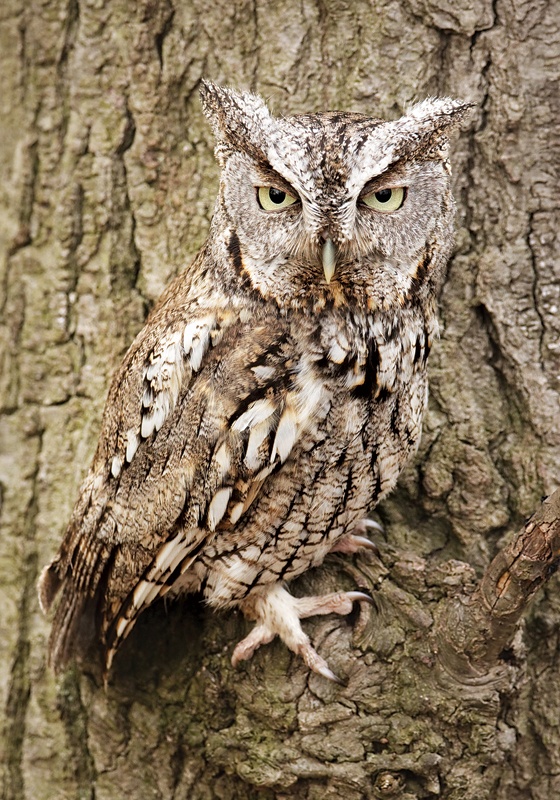Wearing a baseball cap and glasses and carrying a brown paper shopping bag, Fred Gehlbach climbs a ladder 12 feet from the ground into a gnarled oak tree near his home in Woodway. The object of his ascent is a weathered nest box that houses a family of eastern screech owls, common throughout Texas and most of the eastern U.S. The owlets have been peering out of the box for a couple of days, and this is a sure sign that they will soon fledge. It’s time to band them before they fly.
Gehlbach, a world-renowned authority on eastern screech owls, has spent more than 40 years studying the petite, 7-inch owls and their remarkable adjustment to the urbanization of their habitat. His laboratory near Waco, a 15-acre nature preserve along a ravine that begins at his patio, provided material for two books as well as countless papers and articles. Each publication fills in some of the gaps in knowledge about these small raptors, which have adapted to life in suburbia in the blink of a round, yellow eye.
Even before “Harry Potter” took American bookshelves by storm and brought dramatic attention to owls, these birds enjoyed widespread popularity. Who doesn’t love the deep-voiced hoot of a great horned owl calling to its mate in the navy-blue moments of evening? Owls populate myths and legends worldwide, symbolizing wisdom and knowledge for some cultures and heralding death and dread for others.
Gehlbach, a professor emeritus at Baylor University, and his wife, Nancy, design and build nest boxes, about the size of shoeboxes, to replace nesting locations cleared by suburban homeowners who rarely realize they are leaving owl families homeless as they haul away hollow limbs and trunks. The Gehlbachs have followed bird migrations across the Americas, studied colonies of owls for the National Geographic Society and contributed research to a project that is mapping the DNA of birds worldwide.
Gehlbach’s banding project occurs an hour before dusk when the owls are still asleep. The male, his gray streaked feathers blending into a nearby tree trunk, seems unperturbed. He and his mate have been through this before. “The owls in my study come to know me,” Gehlbach explains, “but they are still wild birds.” He’s had a few stitches in his scalp to re-mind him of this.
Gently opening the hinged top of the nest box, he reaches inside and removes four puffy, gray owlets, which he places in the paper bag. The chicks are calm and silent except for a clicking noise they make with their beaks. Descending with his precious cargo, Gehlbach carefully removes one chick at a time, offering each a pencil to hold in its sharp little talons. “It makes them feel more secure,” he explains, “and they are not so likely to grip my fingers.” He applies a lightweight aluminum band to the left leg of each chick, its number registered with the U.S. Fish and Wildlife Service. Before returning them to the nest, he weighs each chick and plucks a single feather for DNA testing.
Gehlbach’s screech owl research has turned up interesting information gleaned from the inhabitants of the 20 or so owl boxes scattered throughout his neighborhood and in nearby woodlands. Of the 1,453 eastern screech owls that have participated in the study, more birds nest in wooded suburbs than in rural areas. This trend is partly because of abundant birdbaths, available food and fewer predators. Homeowners may not know there is a screech owl nesting in their yards unless they hear the single-note trill that is the screech owl’s most frequent call. Screech owls only screech in times of extreme distress. During the day, the birds snooze near the trunk of a tree, all but invisible against the mottled bark.
Eastern screech owls are messy housekeepers. Debris carpets the floor of the nest cavity as the female and chicks drop bits of food. Flies and ants feed on the detritus and lay their eggs on the scraps from the owls’ meals. During his research, Gehlbach discovered a strange and previously unknown “mutualism” in which Texas blind snakes occupy active screech owl nests, benefitting both the owls and the snake.
Blind snakes spend most of their time below ground, inside ant colonies or hidden in the leaf litter of the forest floor. With their pinkish color, smooth scales and length of 5 to 10 inches, they are often mistaken for earthworms. Dropped into an owl’s nest alive by the parent owls, the snake retreats beneath the debris on the floor, where it feeds on larvae that accumulate on the owls’ leftovers, keeping the nest cleaner.
“Consumption of larvae may reduce larval parasitism on owl nestlings or larval competition with nestlings for food stored in the nest. Nestlings with live-in blind snakes grow faster and experience lower mortality than same-season broods lacking snakes,” Gehlbach says.
Gehlbach’s research also shows that his owls are nesting nearly a month earlier in the spring than they did even a few years ago, and he believes this is a response to climate change. Early nesting usually means more chicks, but it is also a sign that change is underway. Despite the suburban amenities these petite owls enjoy in tree-filled yards, there are hazards involved with human proximity. Fledglings killed by traffic verify what any parent knows instinctively: that the juvenile period when the young strike out on their own is the most dangerous time of an animal’s life.
Recent research shows that owls, along with crows and jays, are among nature’s most intelligent birds. Eastern screech owls readily move into nest boxes mounted at least 10 feet up in a large tree in deep shade and repay their landlords by patrolling for rodents, snakes and large insects while serenading the neighborhood with melodious whistles and trills.
——————–
Martha Deeringer, a member of Heart of Texas EC, lives near McGregor.


